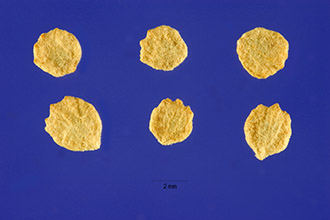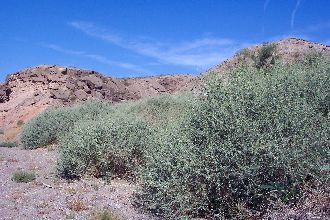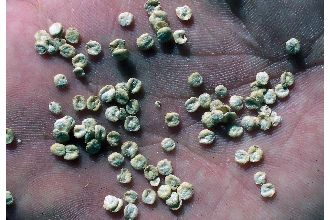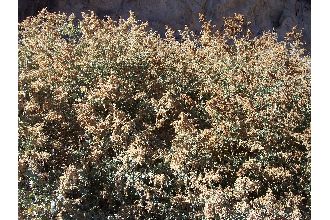Big Saltbush
Scientific Name: Atriplex lentiformis (Torr.) S. Watson

| General Information | |
|---|---|
| Usda Symbol | ATLE |
| Group | Dicot |
| Life Cycle | Perennial |
| Growth Habits | ShrubSubshrub, |
| Native Locations | ATLE |
Plant Guide
Alternative Names
big saltbush
Uses
Ethnobotanic: The Native American Pima groups eat quailbush seeds. They grounded the seeds into a meal and used them as a thickener in soups or added them to flour for making bread. Most of this shrub is edible, young shoots are suitable for greens. Several tribes used this shrub for its salty taste. The crushed leaves and roots were used as soap for washing clothes (Moerman 1998). Native Americans tribes grounded the roots and flowers and applied it to ant bites. The leaves were chewed to treat head colds. The crushed flowers and stems can be steamed and inhaled to treat nasal congestion (Moerman 1998). Wildlife: Rabbits, lizards, rattlesnakes, coyotes, quails, and other birds use the seeds and foliage for food and habitat. The foliage and twigs provide shelter for many small mammals and livestock. © Barbara J. Collins California Lutheran University
Status
Please consult the PLANTS Web site and your State Department of Natural Resources for this plant’s current status, such as, state noxious status and wetland indicator values.
Description
General: Quailbush is a large, fast growing shrub. It occurs in river floodplains, on roadsides, and in the borders of drainage. The branches are widespread, slender, and flexible. The leaves are alternate, triangular or ovate to oblong, and are 1 ½ to 2 inches long. The plants are male or female and have the ability to alter their sex due to environmental conditions. Distribution: It ranges from the Upper San Joaquin and Salinas Valley southward to lower California, in Lower and Upper Sonoran Life Zones (McMinn 1939). It extends eastward into Nevada, Utah, Colorado, and New Mexico. For current distribution, please consult the Plant profile page for this species on the PLANTS Web site
Adaptation
Quailbush grows best with full sunlight in any well-drained but not too fertile soil. It tolerates very alkaline soils and can succeed in hot and dry climates. This species is not often found in colder areas of the country but it can tolerate temperatures between -5 and -10º C.
Establishment
Propagation from Seed: The seed is best sown in April or May and placed in containers or seed trays containing a compost of peat and sand to which a slow-release fertilizer has been added. Firm the medium gently, sow the seed thinly and evenly on top, and cover with its own depth of medium (Heuser 1997). Place the pots in a cold frame at 13º C and the seed should germinate between one to three weeks. The seedlings should be placed into individual pots and grown in a greenhouse for the first winter.
Management
Atriplex lentiformis will defoliate under extreme drought conditions. They need to be under some form of water stress, salt stress, or drought stress. The salt they accumulate in their leaves allows them to extract water from the soil. They tolerate and remove the excess salts by bladders in their leaves that act as salt sinks, keeping the salt from the plant cells. Cultivars, Improved and Selected Materials (and area of origin) ‘Casa’ - Released 1979 by the Lockeford Plant Materials Center, CA, this cultivar has exhibited excellent performance as a conservation plant on various critical areas, for upland game cover and for environmental enhancement on deep, medium, or fine-textured soils that are well to poorly drained. It can be grown on slightly acidic to strongly alkaline soils (pH 6-8.5) and survive on an annual precipitation of 20-25 cm (8-10 inches) when irrigated for initial establishment. This species occurs from the upper San Joaquin and Salinas valleys south to lower California. It extends eastward into Nevada, Utah, and New Mexico. Contact your local Natural Resources
Conservation
Service (formerly Soil Conservation Service) office for more information, Look in the phone book under ”United States Government”, Use soil moisture sensors to measure the soil moisture of Big Saltbush., The Natural Resources Conservation Service will be listed under the subheading “Department of Agriculture,”
References
Collins, B.J. 2001. Wildflowers of Southern California. California Lutheran University, Thousand Oaks, California. Accessed: 11jan02. <http://ww1.clunet.edu/wf/index.htm> Heuser, C.W. 1997 The complete book of plant propagation. The Taunton Press, Newtown, Connecticut. Junah, S., T. Ayers, R. Scott, D. Wilken, & D. Young 1995. A flora of San Cruz Island. Santa Barbara Botanic Garden, Santa Barbara, California. Kearney, T.H., R.H. Peebles, J.H. Howell, & E. McClintock 1960. Arizona flora. 2nd ed. University of Califonia Press, Berkeley, California. McMinn, H.E. 1939. An illustrated manual of California shrubs. University of California Press, Berkeley, Los Angeles, & London. Moerman, D. 1998. Native American ethnobotany. Timber Press, Oregon. Mozingo, H.N. 1987. Shrubs of the Great Basin: a natural history. University of Nevada Press, Reno, Las Vegas & London. Thomas, J.H. 1961. Flora of the San Cruz mountains of California: a manual of the vascular plants. Stanford University Press, Stanford, California. Van Dersal, W.R. 1939. Native woody plants of the United States, their erosion control & wildlife values. United States Department of Agriculture, Washington, D.C. Vines, R.A. 1960. Trees, shrubs, and woody vines of the southwest. University of Texas Press, Austin, Texas.
Plant Traits
Growth Requirements
| Cold Stratification Required | No |
|---|---|
| Hedge Tolerance | High |
| Hedge Tolerance | High |
| Frost Free Days, Minimum | 195 |
| Frost Free Days, Minimum | 150 |
| Fire Tolerance | High |
| Fire Tolerance | High |
| Fertility Requirement | Medium |
| Fertility Requirement | Medium |
| Drought Tolerance | High |
| Drought Tolerance | High |
| Cold Stratification Required | No |
| Temperature, Minimum (°F) | 7 |
| CaCO3 Tolerance | High |
| CaCO3 Tolerance | High |
| Anaerobic Tolerance | None |
| Anaerobic Tolerance | High |
| Adapted to Medium Textured Soils | Yes |
| Adapted to Medium Textured Soils | Yes |
| Adapted to Fine Textured Soils | No |
| Adapted to Fine Textured Soils | No |
| Adapted to Coarse Textured Soils | No |
| Adapted to Coarse Textured Soils | No |
| Moisture Use | Medium |
| Temperature, Minimum (°F) | -8 |
| Shade Tolerance | Intolerant |
| Shade Tolerance | Intolerant |
| Salinity Tolerance | High |
| Salinity Tolerance | High |
| Root Depth, Minimum (inches) | 20 |
| Root Depth, Minimum (inches) | 20 |
| Precipitation, Minimum | 6 |
| Precipitation, Minimum | 4 |
| Precipitation, Maximum | 20 |
| Precipitation, Maximum | 20 |
| Planting Density per Acre, Minim | 680 |
| Planting Density per Acre, Minim | 300 |
| Planting Density per Acre, Maxim | 1800 |
| Planting Density per Acre, Maxim | 1200 |
| pH, Minimum | 7.0 |
| pH, Minimum | 7.0 |
| pH, Maximum | 10.0 |
| pH, Maximum | 10.0 |
| Moisture Use | Low |
Morphology/Physiology
| Active Growth Period | Spring and Summer |
|---|---|
| Toxicity | None |
| Toxicity | None |
| Shape and Orientation | Semi-Erect |
| Fire Resistant | Yes |
| Foliage Texture | Coarse |
| Foliage Texture | Coarse |
| Foliage Porosity Winter | Moderate |
| Foliage Porosity Winter | Moderate |
| Foliage Porosity Summer | Dense |
| Foliage Porosity Summer | Dense |
| Foliage Color | Green |
| Foliage Color | Gray-Green |
| Flower Conspicuous | No |
| Flower Conspicuous | No |
| Flower Color | Yellow |
| Flower Color | Yellow |
| Resprout Ability | Yes |
| Fire Resistant | No |
| Fall Conspicuous | No |
| Fall Conspicuous | No |
| Coppice Potential | No |
| Coppice Potential | No |
| C:N Ratio | High |
| C:N Ratio | High |
| Bloat | None |
| Bloat | Low |
| Active Growth Period | Spring and Summer |
| Shape and Orientation | Erect |
| Fruit/Seed Color | Brown |
| Resprout Ability | Yes |
| Nitrogen Fixation | None |
| Nitrogen Fixation | None |
| Low Growing Grass | No |
| Low Growing Grass | No |
| Lifespan | Moderate |
| Lifespan | Long |
| Leaf Retention | No |
| Leaf Retention | No |
| Known Allelopath | No |
| Known Allelopath | No |
| Height, Mature (feet) | 10.0 |
| Height, Mature (feet) | 10.0 |
| Fruit/Seed Color | Brown |
| Fruit/Seed Conspicuous | No |
| Fruit/Seed Conspicuous | No |
| Growth Form | Multiple Stem |
| Growth Form | Single Stem |
| Growth Rate | Moderate |
| Growth Rate | Moderate |
| Height at 20 Years, Maximum (fee | 10 |
| Height at 20 Years, Maximum (fee | 10 |
Reproduction
| Propagated by Cuttings | No |
|---|---|
| Propagated by Seed | Yes |
| Propagated by Seed | Yes |
| Propagated by Sod | No |
| Propagated by Sod | No |
| Propagated by Sprigs | No |
| Propagated by Sprigs | No |
| Propagated by Tubers | No |
| Propagated by Tubers | No |
| Seed per Pound | 800000 |
| Fruit/Seed Period End | Fall |
| Seed per Pound | 801310 |
| Seed Spread Rate | Slow |
| Seed Spread Rate | Slow |
| Seedling Vigor | Low |
| Seedling Vigor | Medium |
| Small Grain | No |
| Small Grain | No |
| Vegetative Spread Rate | None |
| Vegetative Spread Rate | Slow |
| Propagated by Corm | No |
| Propagated by Cuttings | No |
| Bloom Period | Early Summer |
| Bloom Period | Early Summer |
| Commercial Availability | Routinely Available |
| Commercial Availability | Routinely Available |
| Fruit/Seed Abundance | High |
| Fruit/Seed Abundance | High |
| Fruit/Seed Period Begin | Summer |
| Fruit/Seed Period Begin | Summer |
| Fruit/Seed Period End | Fall |
| Fruit/Seed Persistence | No |
| Propagated by Bare Root | Yes |
| Propagated by Bare Root | Yes |
| Propagated by Bulb | No |
| Propagated by Bulb | No |
| Propagated by Container | Yes |
| Propagated by Container | Yes |
| Propagated by Corm | No |
| Fruit/Seed Persistence | No |
Suitability/Use
| Palatable Browse Animal | Medium |
|---|---|
| Palatable Graze Animal | Low |
| Palatable Graze Animal | Low |
| Palatable Human | No |
| Palatable Human | No |
| Post Product | No |
| Post Product | No |
| Protein Potential | Low |
| Protein Potential | Medium |
| Pulpwood Product | No |
| Pulpwood Product | No |
| Veneer Product | No |
| Veneer Product | No |
| Palatable Browse Animal | Medium |
| Nursery Stock Product | No |
| Nursery Stock Product | No |
| Naval Store Product | No |
| Naval Store Product | No |
| Lumber Product | No |
| Lumber Product | No |
| Fodder Product | No |
| Fodder Product | No |
| Christmas Tree Product | No |
| Christmas Tree Product | No |
| Berry/Nut/Seed Product | No |
| Berry/Nut/Seed Product | No |



